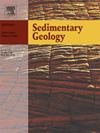法国南部Minervois盆地EECO热液期季风型事件引发的大陆沉积突变
IF 2.9
2区 地球科学
Q1 GEOLOGY
引用次数: 0
摘要
最近对早始新世气候的研究表明,以大气中负碳同位素漂移(CIE, hypertherals)为特征的全球气候变暖是导致亚热带盆地陆相沉积记录急剧变化的原因。在此,我们提供了一个重要的沉积记录,以了解地质和气候变化,以评估早始新世气候最佳(EECO)时期欧洲大陆背景下热液对沉积物运输和沉积的影响。在沉积学、层序地层学、磁地层学和化学地层学(碳同位素δ13Corg)综合研究的基础上,提出了法国南部Minervois盆地陆相沉积系的详细约束年代地层格架。通过相组合分析,将沉积序列划分为3个陆相层序,陆相层序以内生欠填盆地发育形成的陆相不整合为界。该层序由河漫滩-湖浅湖相碳酸盐岩组成,反映了EECO时期的干旱气候条件。它们周期性地被突然到来的碎屑流打断,这些碎屑流带有与短暂的多层辫状河道平原相关的超临界河床沉积,反映了内陆强烈和极端的降雨事件。后者与C24n超热相对应的CIEs重合。1nH1/K (ETM3), C23rH2 (M)和C23n.2nH1-C23n。2nH2 (NO)间隔。极端季风型事件是由超热活动期间的强烈升温引发的,可以用来解释盆地中突然的碎屑输入。这项工作证实了瞬时热液可以在沉积记录中产生剧烈的水文变化。本文章由计算机程序翻译,如有差异,请以英文原文为准。
Abrupt changes in continental sedimentation triggered by monsoon-type event during EECO hyperthermals, Minervois Basin, Southern France
Recent studies on Early Eocene climate have established that global climatic warming, characterized by negative carbon isotopic excursions (CIE, hyperthermals) in the atmosphere, are responsible for drastically changes in the terrestrial sedimentary record of sub-tropical basins. Here we present a key sedimentary record to understand geological and climatological changes in order to evaluate the impact of hyperthermals on sediment transport and deposition in continental setting during the Early Eocene Climatic Optimum (EECO) in Europe. Based on an integrative study combining sedimentology, sequential stratigraphy, magnetostratigraphy and chemostratigraphy (carbon isotopes, δ13Corg), the study proposes a detailed constrained chronostratigraphic framework of continental sedimentary series of the Minervois Basin (South of France). Using facies association analysis, the sedimentary succession is divided into three continental sequences bounded by subaerial unconformity deposited through the development of an endoreic underfilled basin. The sequences are composed of floodplain to palustrine-shallow lacustrine carbonate deposits reflecting arid climatic conditions during the EECO. They are cyclically punctuated by the sudden arrival of detrital fluxes with deposits of supercritical bedforms associated to an ephemeral multistorey braided channel plain, reflecting intense and extreme rainfall events in the hinterland. The latter coincides to CIEs corresponding to hyperthermals identified as C24n.1nH1/K (ETM3), C23rH2 (M), and C23n.2nH1-C23n.2nH2 (N![]() O) interval. Extreme monsoon-type events triggered by intense warm-ups during hyperthermals are proposed to explain sudden detrital inputs in the basin. This work confirms that transient hyperthermals can generate drastic hydrological changes in the sedimentary record.
O) interval. Extreme monsoon-type events triggered by intense warm-ups during hyperthermals are proposed to explain sudden detrital inputs in the basin. This work confirms that transient hyperthermals can generate drastic hydrological changes in the sedimentary record.
求助全文
通过发布文献求助,成功后即可免费获取论文全文。
去求助
来源期刊

Sedimentary Geology
地学-地质学
CiteScore
5.10
自引率
7.10%
发文量
133
审稿时长
32 days
期刊介绍:
Sedimentary Geology is a journal that rapidly publishes high quality, original research and review papers that cover all aspects of sediments and sedimentary rocks at all spatial and temporal scales. Submitted papers must make a significant contribution to the field of study and must place the research in a broad context, so that it is of interest to the diverse, international readership of the journal. Papers that are largely descriptive in nature, of limited scope or local geographical significance, or based on limited data will not be considered for publication.
 求助内容:
求助内容: 应助结果提醒方式:
应助结果提醒方式:


